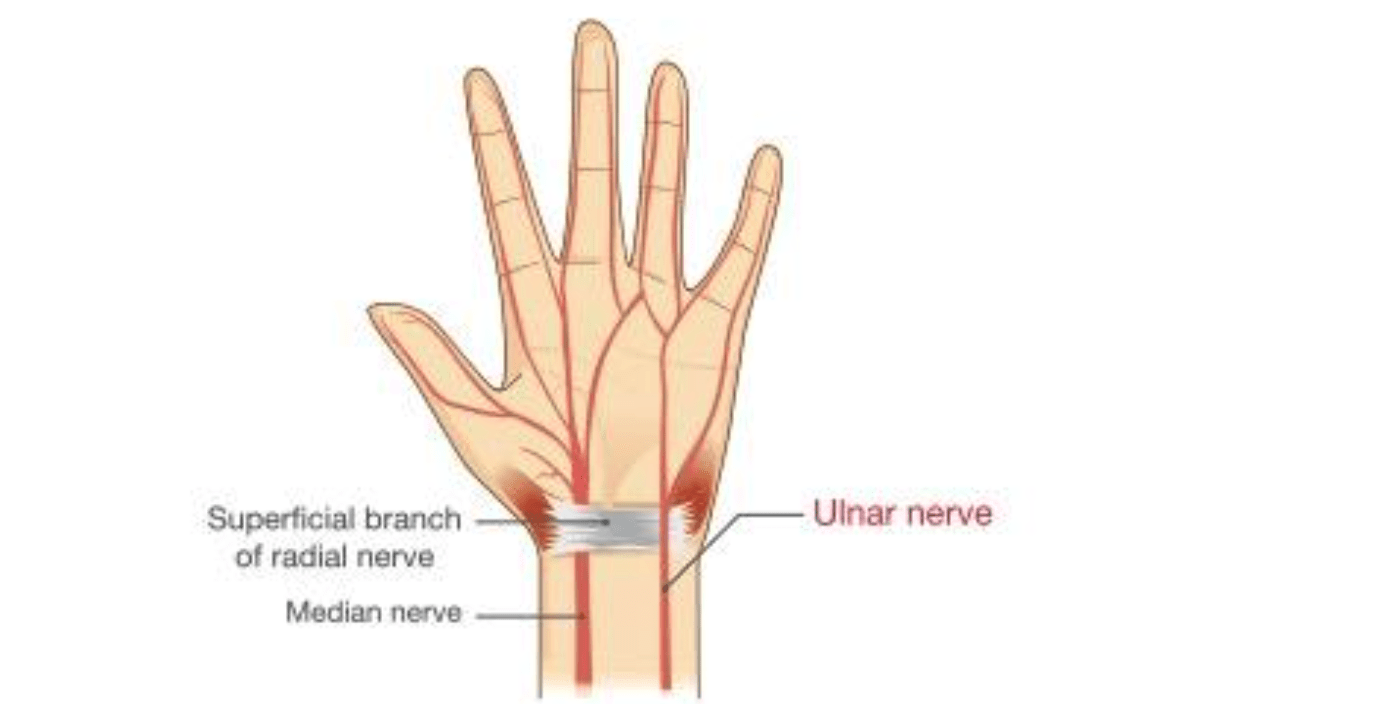
Ulnar tunnel syndrome of the wrist is a condition that affects the ulnar nerve. The ulnar nerve starts near where your neck meets your shoulder. It runs through your elbow and down to the outer edge of your hand. It’s one of three main nerves that provides sensation and movement to the ring finger, little finger, and part of the palm. When the nerve becomes compressed or damaged, as it passes through a narrow passage in the wrist called the ulnar tunnel it can lead to a range of symptoms, collectively known as ulnar tunnel syndrome. Symptoms of the condition include pain, tingling, or numbness in your hand, caused by a pinched nerve in your wrist. It isn’t pleasant, but treatments and simple changes to your routine can help you feel better quickly.
Ulnar tunnel syndrome is carpal tunnel’s lesser-known cousin. Like the median nerve passes through the carpal tunnel in your hand, the ulnar nerve passes through Guyon’s canal [you might even hear your doctor call it Guyon’s canal syndrome] at your wrist. Sometimes both conditions can cause a problem in the same hand.

The compression can be caused by several factors, including:
- Repetitive stress or overuse: Activities that involve repetitive motions of the wrist, such as typing or playing an instrument, can lead to ulnar tunnel syndrome.
- Injury: A direct blow or trauma to the wrist can damage the ulnar nerve and cause ulnar tunnel syndrome.
- Anatomical abnormalities: Certain anatomical abnormalities, such as a ganglion cyst or a bone spur, can compress the ulnar nerve and cause ulnar tunnel syndrome. Ganglion cysts are noncancerous fluid-filled sacs that form near your wrist joint. These cysts cause up to 40% of Guyon’s canal syndrome.
What are the risk factors for ulnar nerve entrapment?
Ulnar nerve entrapment affects more men than women. People who do jobs or activities that require a lot of elbow or wrist pressure or stretching are most at risk, such as:
- Baseball players, golfers and tennis players
- Bicyclists
- Construction workers
- People who smoke
- Typists, writers and others who use a keyboard frequently
- Weightlifters
Symptoms
The symptoms of ulnar tunnel syndrome of the wrist can vary depending on the severity of the condition. Some common symptoms include:
- Numbness or tingling in the ring finger, little finger, and part of the palm
- Weakness in the hand and wrist
- Pain or discomfort in the wrist or hand
- Difficulty gripping objects or performing fine motor tasks
- A feeling of pins and needles or burning sensation in the affected area
Diagnosis
To diagnose ulnar tunnel syndrome of the wrist, a doctor will typically perform a physical examination and may order imaging tests such as an X-ray or MRI. The doctor may also perform a nerve conduction study, which involves stimulating the nerve with small electrical impulses and measuring the response to determine the extent of the damage.
Treatment
The treatment for ulnar tunnel syndrome of the wrist depends on the severity of the condition. Mild cases may be treated with rest, ice, and over-the-counter pain relievers. More severe cases may require splinting, physical therapy, or even surgery to relieve pressure on the nerve.
Prevention and Risk Reduction
Although there are no specific preventive measures that can stop all cases of ulnar tunnel syndrome from developing you may be able to reduce your risk with certain precautions. Follow these tips:
- Take breaks at work to let your wrists and hands rest
- Use less force and a lighter grip to complete tasks
- Avoid repetitive tasks or work
- Avoid using vibrating tools
- Use ergonomic and padded tools
- Maintain good posture and ergonomics
- Take breaks frequently to stretch and rest the hands and wrists
- Keep your hands and wrists warm
It is important to seek medical attention if you experience any of the symptoms of ulnar tunnel syndrome of the wrist to prevent further damage and ensure the best possible outcome.
The specialists at SRO’s Hand and Wrist Center can diagnose the damage and create a treatment plan for optimal recovery.

